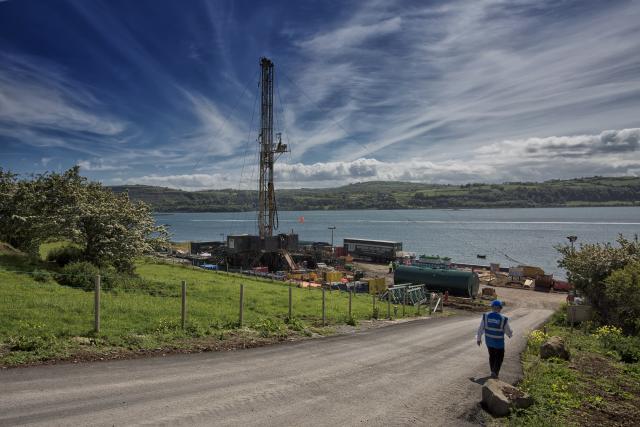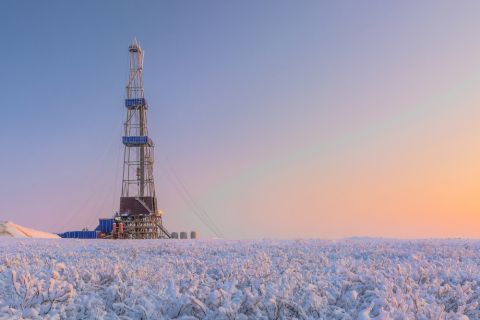
A salt exploration well drilled in 2015 found gas shows. (Source: Islandmagee Storage Ltd.)
Europe’s Carboniferous basins have long been prolific sources of hydrocarbons and characterize many of the fields in and around the North Sea. But one of these basins is virtually overlooked. The Larne Basin in Northern Ireland is a classic Carboniferous basin that has remained unexplored for a couple of reasons. Firstly, historical “troubles” in Northern Ireland deterred the oil companies who were exploring elsewhere onshore and offshore in the U.K. at the time. Secondly, the basin is covered by volcanic basalts that until recently couldn’t be properly imaged through with seismic.
But this is about to change. A group of small companies, including Horizon Energy Partners LLC and Petro River Oil Corp. in the U.S. and InfraStrata Plc, Brigantes Energy Ltd., Terrain Energy Ltd., Ermine Resources Ltd., Baron Oil Plc and Tudor Hall Energy Ltd. in the U.K., currently have under license about 130,000 acres, distributed both onshore and offshore, and are expecting to spud their first conventional exploration well this month. Jonathan Rudney, Horizon’s CEO, is extremely bullish on the prospect. Rudney has been in the business for 35 years and has seen his share of exciting opportunities.
“But of all of the opportunities that I’ve seen in the last decade, there’s just nothing like this,” he said.
There are numerous reasons for his excitement. There’s minimal political risk, excellent fiscal terms and easy availability of infrastructure and sales markets. The market for natural gas, which sells for $6 to $7 per thousand cubic feet, is particularly favorable. It’s also quite shallow, with the reservoir targets at about 2,000 m (6,562 ft). And Rudney said the first prospect to be drilled has a potential of 25 MMbbl to 30 MMbbl.
“We’re onshore in a favorable environment for exploration and production,” he said. “Such opportunities are few and far between.”
A well drilled by Shell in 1971 found a couple of reservoirs, a Triassic reservoir called the Sherwood and a Permian reservoir called the Collyhurst. So reservoir risk is minimal. Traps are also abundant, and Rudney said that even with sparse 2-D seismic data, “you might have lines that were a mile and a half apart, and you can see the same structure on both lines.” The missing part of the story was confirmation of a source rock.
In 2015 a company affiliated with one of the Larne Basin groups was drilling a test well as part of a salt cavern gas storage project near the concession and found “great gas shows” just below the salt. Considerable technical work determined that the gas could only have come from a Carboniferous source.
“That was the only possible source of this gas,” he said. “It was a very positive outcome.
“Not making a major discovery on the first well would, in my mind, also be a success if we confirm the presence of an active and mature petroleum system within the basin,” he said. “This is a large basin, and just from the mapping on the 2-D seismic, the P-50 unrisked reserves are well in excess of 1 Bbbl.”
Contact the author at rduey@hartenergy.com.
Recommended Reading
Wayangankar: Golden Era for US Natural Gas Storage – Version 2.0
2024-04-19 - While the current resurgence in gas storage is reminiscent of the 2000s —an era that saw ~400 Bcf of storage capacity additions — the market drivers providing the tailwinds today are drastically different from that cycle.
Biden Administration Criticized for Limits to Arctic Oil, Gas Drilling
2024-04-19 - The Bureau of Land Management is limiting new oil and gas leasing in the Arctic and also shut down a road proposal for industrial mining purposes.
SLB’s ChampionX Acquisition Key to Production Recovery Market
2024-04-19 - During a quarterly earnings call, SLB CEO Olivier Le Peuch highlighted the production recovery market as a key part of the company’s growth strategy.
PHX Minerals’ Borrowing Base Reaffirmed
2024-04-19 - PHX Minerals said the company’s credit facility was extended through Sept. 1, 2028.
Exclusive: The Politics, Realities and Benefits of Natural Gas
2024-04-19 - Replacing just 5% of coal-fired power plants with U.S. LNG — even at average methane and greenhouse-gas emissions intensity — could reduce energy sector emissions by 30% globally, says Chris Treanor, PAGE Coalition executive director.





